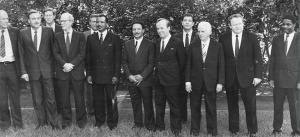Difference between revisions of "Brazzaville Protocol"
m |
m |
||
| Line 3: | Line 3: | ||
|image=Brazzaville_Protocol.jpg | |image=Brazzaville_Protocol.jpg | ||
|image_width=300px | |image_width=300px | ||
| + | |image_caption=At the preliminary Brazzaville negotiations are (left to right) [[South Africa]]n Defence Minister [[Magnus Malan]], Foreign Minister [[Pik Botha]], US Assistant Secretary of State [[Chester Crocker]] and (2nd from right) UN Under Secretary-General for Administration [[Martti Ahtisaari]] | ||
|start=13 December 1988 | |start=13 December 1988 | ||
|end=13 December 1988 | |end=13 December 1988 | ||
Revision as of 13:37, 22 December 2024
 At the preliminary Brazzaville negotiations are (left to right) South African Defence Minister Magnus Malan, Foreign Minister Pik Botha, US Assistant Secretary of State Chester Crocker and (2nd from right) UN Under Secretary-General for Administration Martti Ahtisaari | |
| Date | 13 December 1988 |
|---|---|
| Interest of | Roland Darroll |
The Brazzaville Protocol is a Preliminary Agreement pursuant to UN Security Council Resolution 435 of 1978 which committed Cuba and South Africa to signing a Comprehensive Agreement to withdraw their troops from Angola.[1]
Formally an Agreement between the Government of the Republic of Cuba and the Government of the People's Republic of Angola for the Conclusion of the Internationalist Mission of the Cuban Military Contingent, the Brazzaville Protocol mandated the withdrawal of Cuban troops from Angola, paving the way for Namibia's independence through the New York Accords.
Representatives from the governments of Angola, Cuba, and South Africa signed the Brazzaville Protocol on 13 December 1988 in Brazzaville, Congo.[2]
Linkage
In 1981, Chester Crocker, US assistant secretary of state for African affairs for newly elected President Ronald Reagan, had developed a linkage policy, tying apartheid South Africa's agreement to relinquish control of Namibia to Cuba's troop withdrawal and peace in Angola.
During the summer of 1986, a first informal meeting was organised by French businessman Jean-Yves Ollivier and French president's counsellor for African affairs Jean-Christophe Mitterrand between senior South African, Mozambican and Angolan representatives, in the Kalahari Desert.
On 10 September 1986, Fidel Castro made Crocker's proposal a prerequisite to withdrawal from Angola. The South African government did as well. The Angolan and American governments began negotiating in June 1987, and the Cuban government joined negotiations on 28 January 1988. All three parties held a round of negotiations on 9 March 1988 in London.
Military action
Meanwhile, UNITA and South African forces stopped and repelled an MPLA advance on UNITA regions in strongholds in Southern Angola ending with the Battle of Cuito Cuanavale in Cuando Cubango province from 13 January to 23 March 1988, when UNITA and South Africa retreated after a 15-hour battle and moved for negotiations. This was the largest conventional battle in Africa since World War II.
Negotiations
On 3 May 1988, the South African government joined the negotiations around Crocker's proposal, and all four parties met in June and August in New York City and Geneva. All parties approved an outline agreement of Principles for a Peaceful Settlement in South Western Africa on 20 July 1988, and agreed to a ceasefire on 8 August 1988. The Brazzaville Protocol was finally signed on 13 December 1988.[3]
Tripartite Agreement
The New York Accords granting independence to Namibia from South Africa and ending the direct involvement of foreign troops in the Angolan Civil War were signed on 22 December 1988 at the United Nations headquarters in New York City by the Foreign Ministers of People's Republic of Angola (Afonso Van-Dunem), Republic of Cuba (Isidoro Malmierca Peoli)] and Republic of South Africa (Pik Botha).
References
Wikipedia is not affiliated with Wikispooks. Original page source here